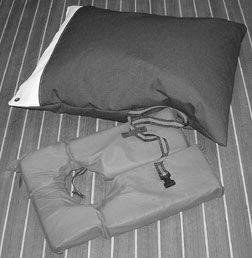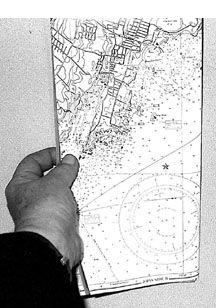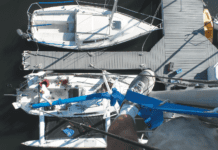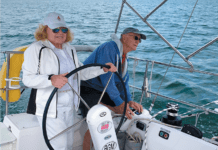Passage Pillow
As we all know, sailing involves a lot of sitting, and for some reason, sitting on most boats is about as comfortable as riding a park bench (that’s assuming you’re just cruising or resting at anchor, not rail-riding in a race with a perforated toerail cutting into the backs of your thighs). If you fluff your nest as best you can with cockpit cushions, boat cushions, and PFDs, you can get your butt fairly well settled down, but you still have your back to deal with. Cockpit coamings and cabin bulkheads, if they’re reasonably shaped and angled, and given the right height, can support the back fairly well for a couple of hours— but if you’re out for a few days or weeks or months, you’re gonna need somebody, or some thing, to lean on.

Contributing editor Scott Rosenthal recently asked acquaintances of his to send us a product they make in their marine canvas shop—Shadetree Canvas in Baltimore. After using it for hundreds of hours over the past two years on long cruises, the Rosenthals swear by it. It’s called the Passage Pillow.
“We didn’t know what to make of it,” said Scott. “It looked like something that was going to get in the way. Little did we know that the pillow would become the most sought-after luxury item onboard.
“The Passage Pillow is a simple idea, executed well. Basically, it’s an overstuffed pillow that is meant for use in the elements. We have used it for two summer cruises totaling 5,500 miles. We liked it so much, and to quell all the fighting over the one pillow, we got a second one this year for our next cruise.”
The Passage Pillow is made from Sunbrella® with a white Sunsure® Plus drain panel. The drain panel allows water to drain out of the pillow. The pillow is 32″x27″ and approximately 9″ thick. It’s filled with 100% pure bead polystyrene. In one corner of the Sunsure panel is a nickel-plated brass spur grommet for attaching a line to secure the pillow to the boat.
“Our Passage Pillow lives in the cockpit,” said Scott. “Just like with a big throw-pillow at home, the Passage Pillow pushes into a shape that conforms to your body and whatever is behind it. For example, it fits perfectly into that space between the cabin bulkhead and the cockpit seat. It lives out in the weather, dries quickly, and has stood up to the elements. We’re careful to tie it to the boat when the weather kicks up—otherwise, major crew morale problems would occur if we lost it.
“The Passage Pillow comes overstuffed with the polystyrene beads. With use, the beads scrunch down and the pillow’s not as thick, though still very comfortable.
“With a new pillow, the beads have a lot of static electricity. When we used a new Passage Pillow to sleep with, we discovered that our faces could feel the static electricity discharges. Thankfully, this phenomenon quickly went away with use.”
The Passage Pillow is available in Sunbrella colors Pacific Blue, Forest Green, or Toast. Other colors are available on special order. The cost is $65 plus shipping.
Contact – Shadetree Canvas, 2501 Boston St. #20, Baltimore, MD 21224; 410/558-0631; malib@hotmail.com.
———-

Maptech’s Flip-Fold Charts
Over the past couple of years, we’ve been deluged by more and greater marvels of electronic navigation aids. We cover them, we admire them, but still we drone: None of these devices will do you any good if your batteries go dead, or if an electrical connection inside the magic box fails. Yet more and more people buy the gizmos and go out on the water without the faintest idea of how to get home on their own. It’s a fact, and that’s why the manufacturers and publishers of all these devices and programs, along with the Coast Guard and your fretful PS editors, continue to harp and admonish. In your case, good reader, we’re sure we’re preaching to the choir, but to convince you that there’s a bit of an epidemic going on, let us quote from a recent press release from Maptech, announcing a new product: a waterproof training chart called How to Use GPS with Charts—A Navigation Training Chart:
“How to Use GPS with Charts is an outgrowth of hearing countless people ask questions on using GPS with charts. See if this sounds all too familiar. Pointing to a chart they ask:
—I want to go here but how do I find the waypoints to put into my GPS?
—How do I transfer my waypoints from the GPS to see where I am on the chart?
—Where am I and where is this on the chart?
Sends a bit of chill down the spine, doesn’t it?
Conventional paper charts do have their problems. They’re fine to work with on a roomy chart table down below where it’s dry, but they’re a pain where there’s not enough room, or if you’re trying to work your way into a harbor in the rain.
Maptech has come up with a partial answer, in the form of a series of waterproof charts that fold up like roadmaps. They’re called flip-fold charts, and they’ve been on the market for a while. We were alerted to them by an announcement of six new charts covering the Northeast. These are 24″ x 36″ charts, printed on both sides, that fold up to 6″ x 12 “, and can easily be refolded to display the area you’re interested in.
The charts contain all the information you’re used to seeing on large paper charts, and have some helpful additions: Boat-launch locations are noted, as are wrecks and other hot-spots for fishing and diving. GPS latitude and longitude are noted for many important aids to navigation that are often used as waypoints, and courses and distances between waypoints are shown. Detailed insets for popular harbors are provided.
There are over 90 titles available, nationwide. They carry a MSRP of $19.95—and are worth every cent.
Contact – Maptech, 888/839-5551, www.maptech.com.






































